一周の螺旋は円にも見える

一周の螺旋は円にも見える / One Turn of a Spiral Looks Like a Circle
2023

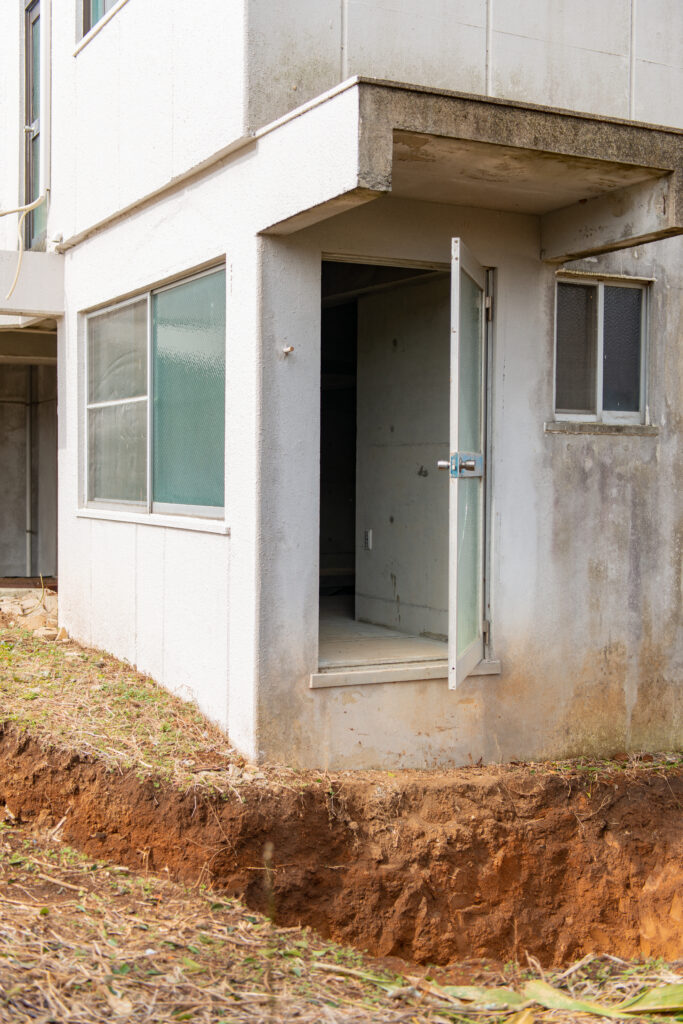
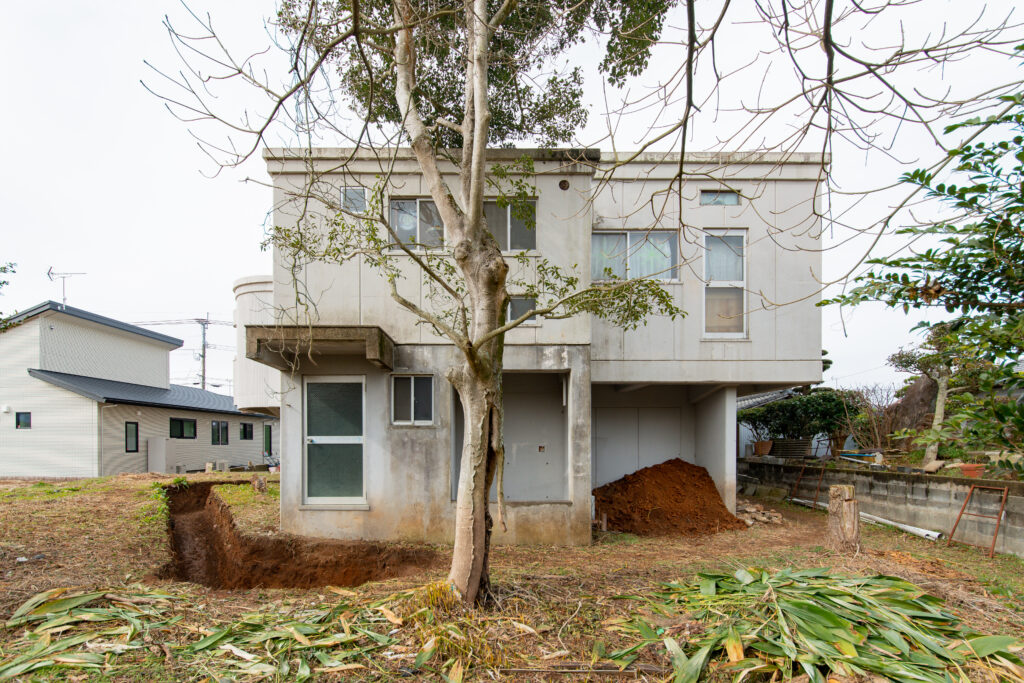
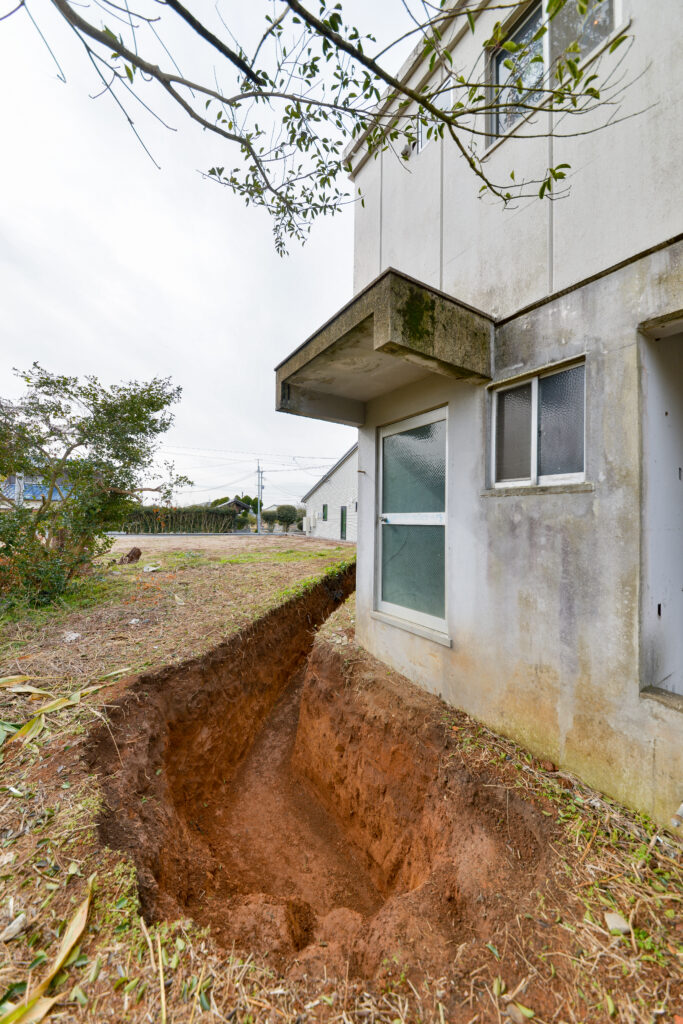
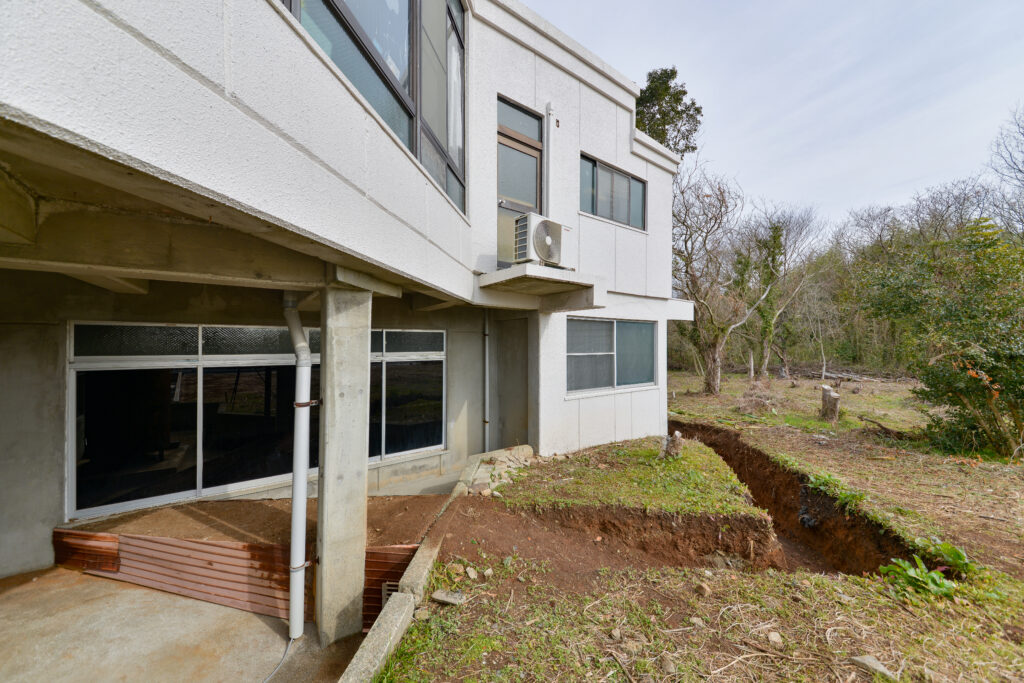
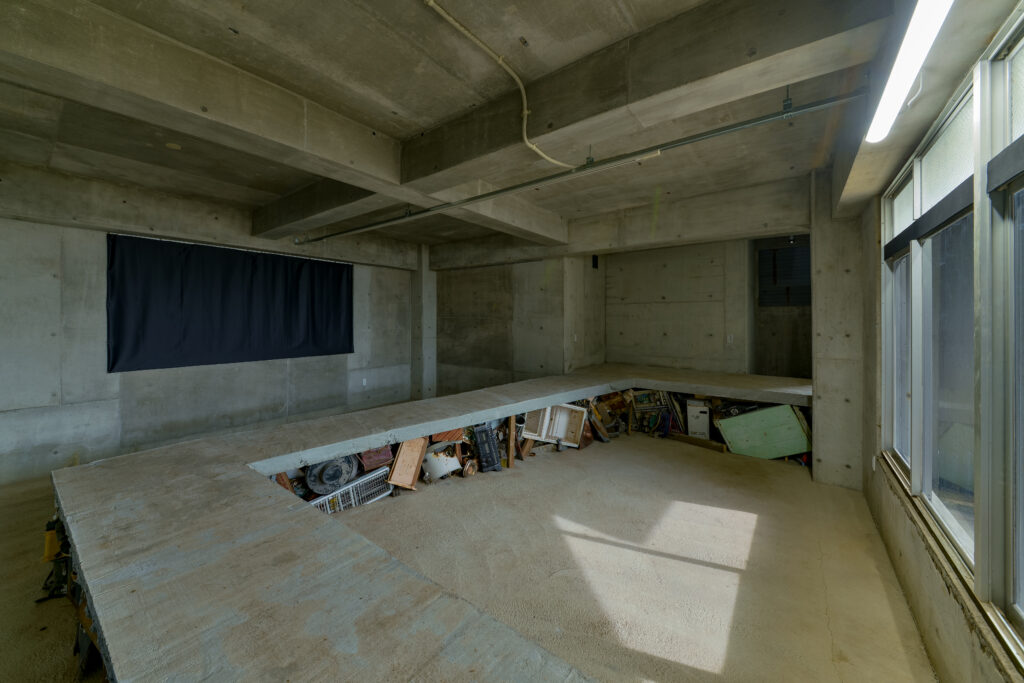
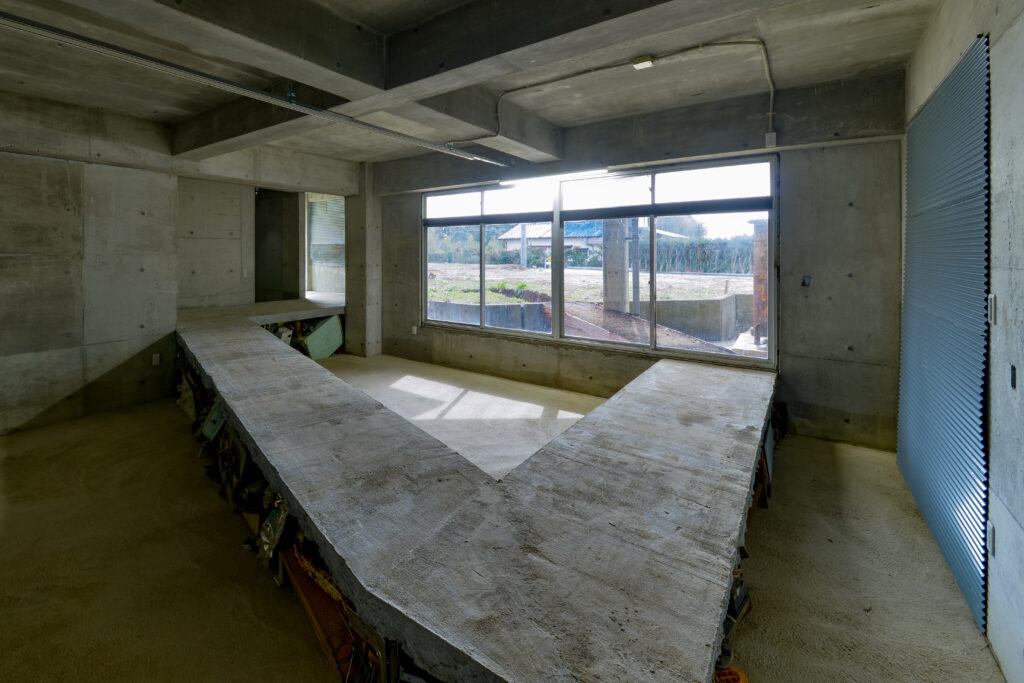
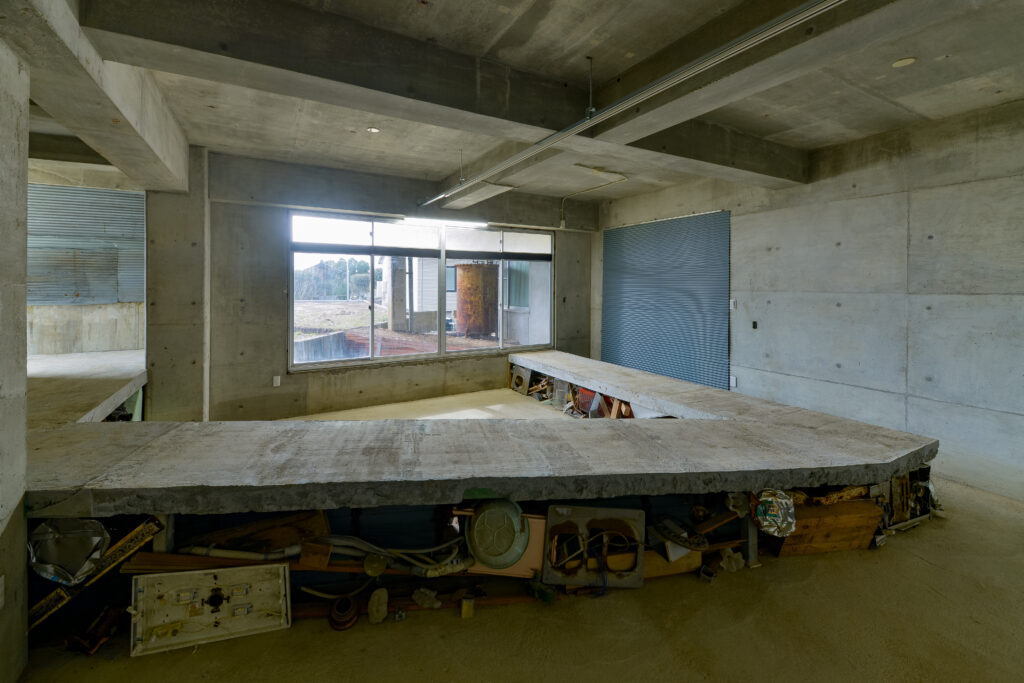
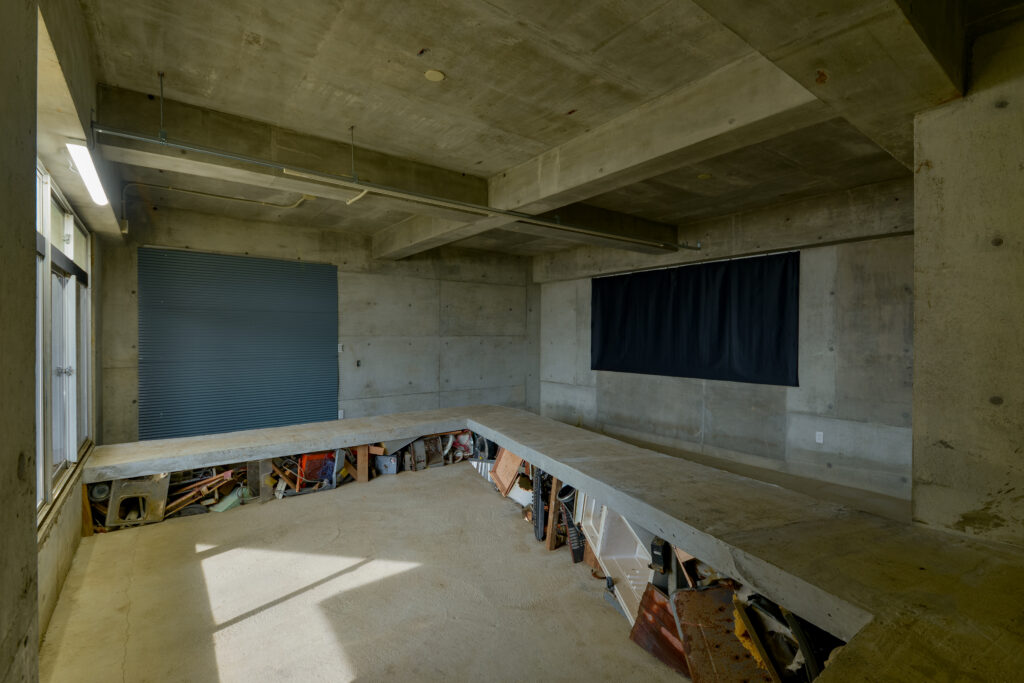
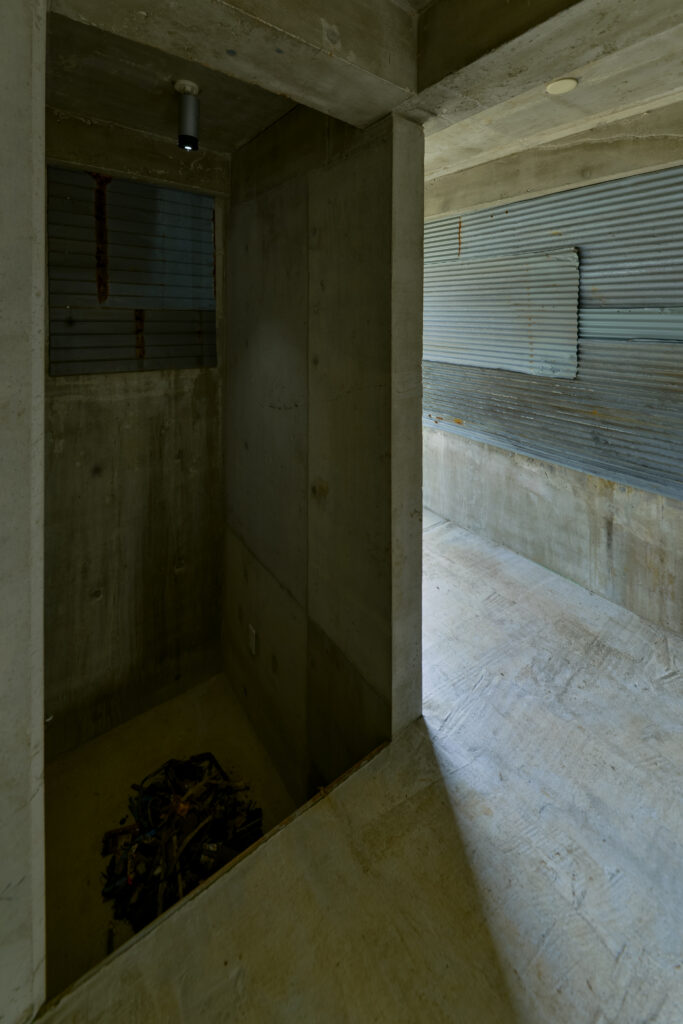
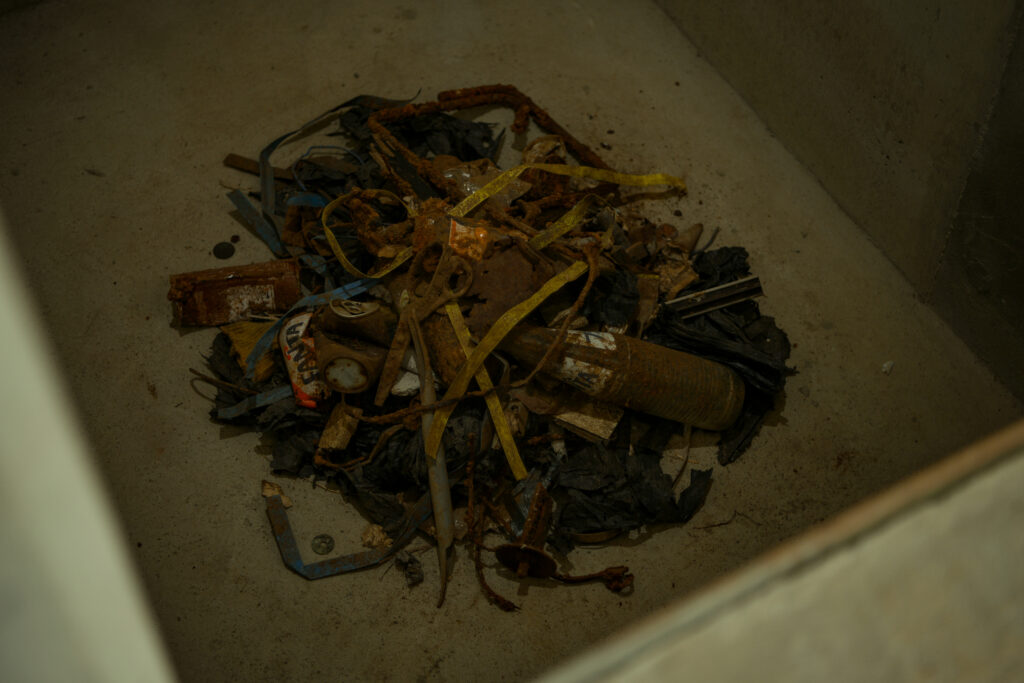

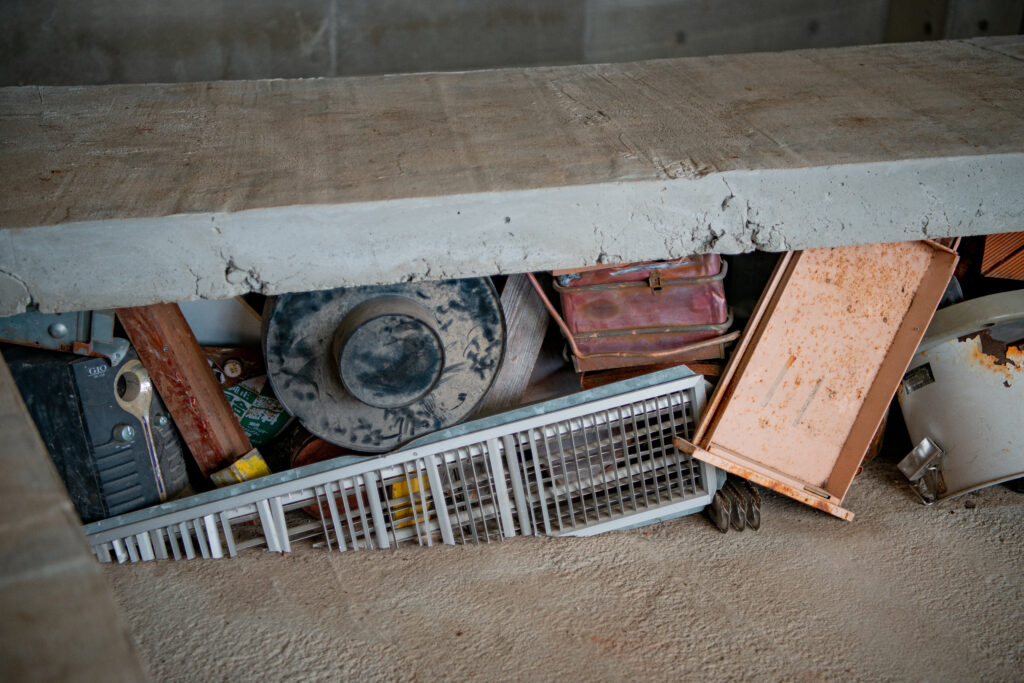
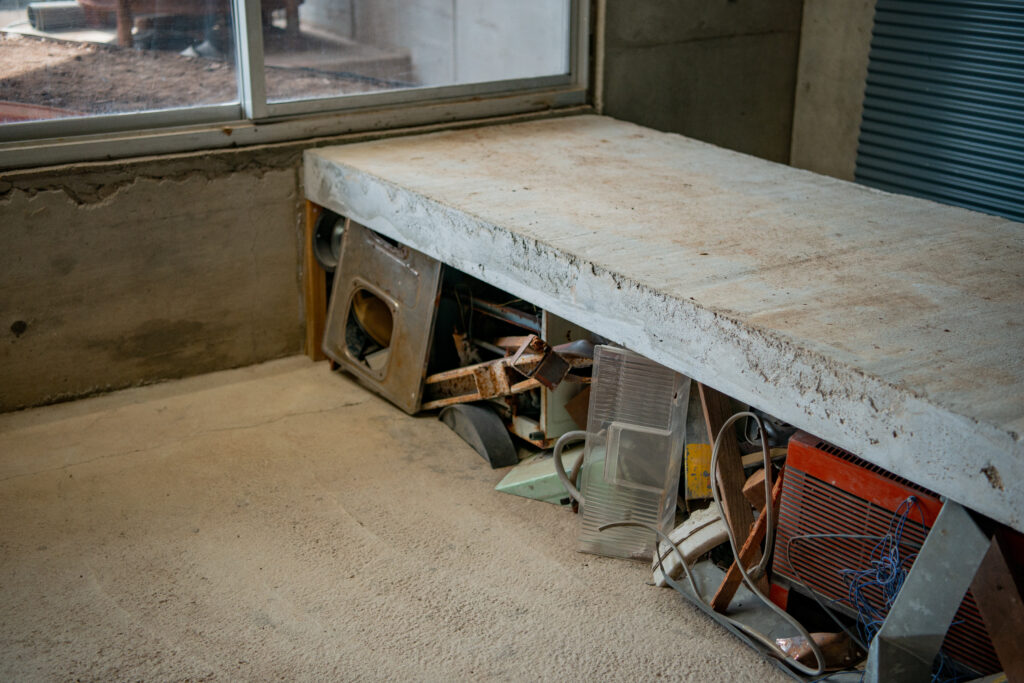
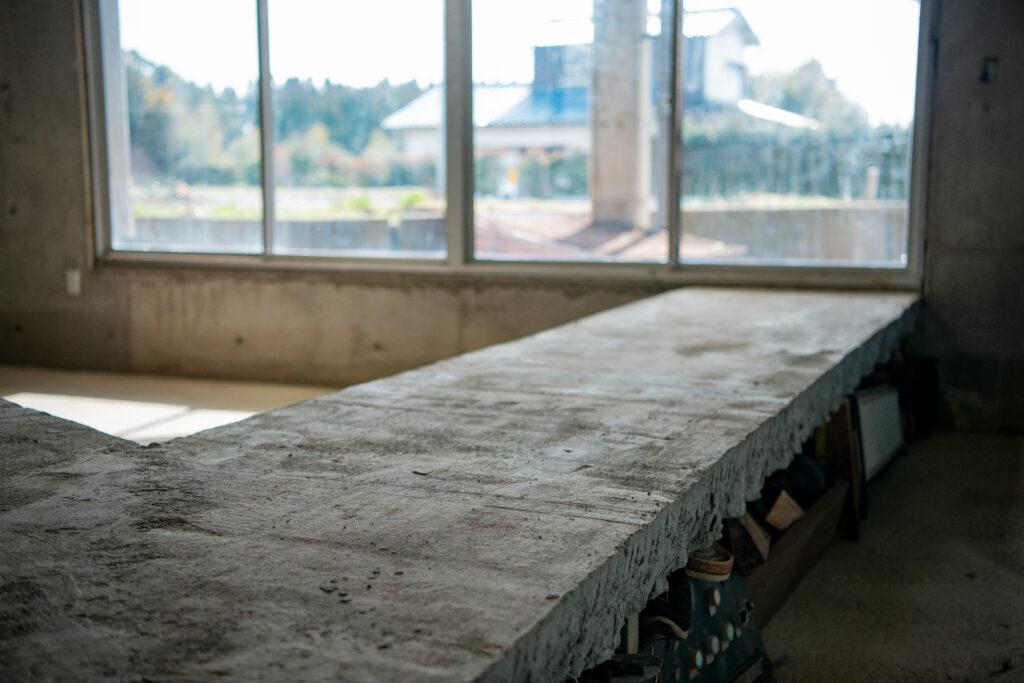
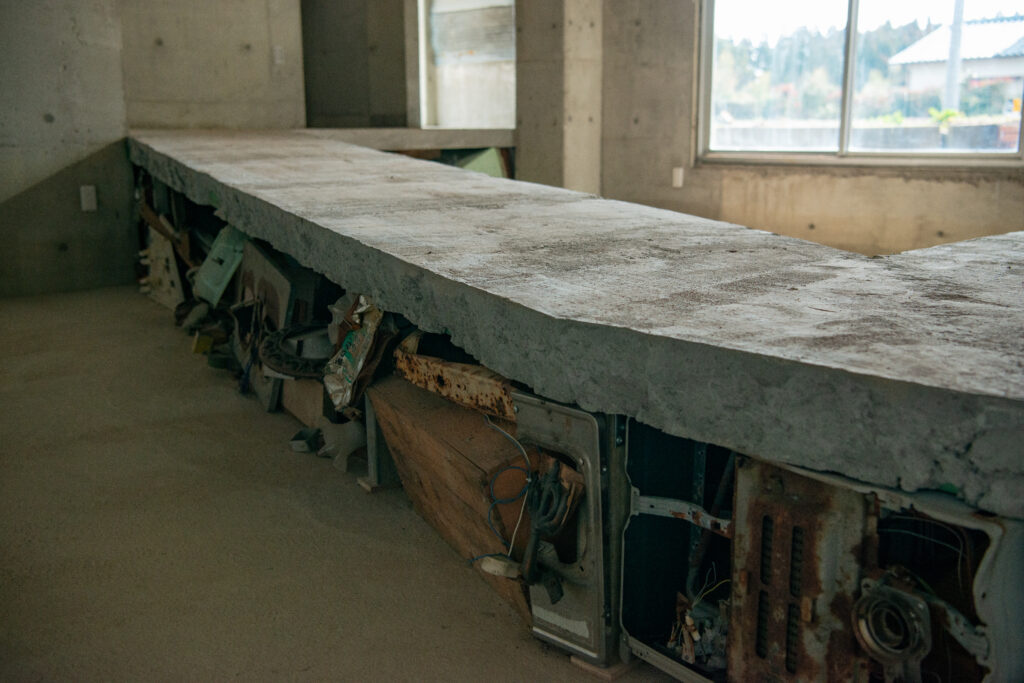
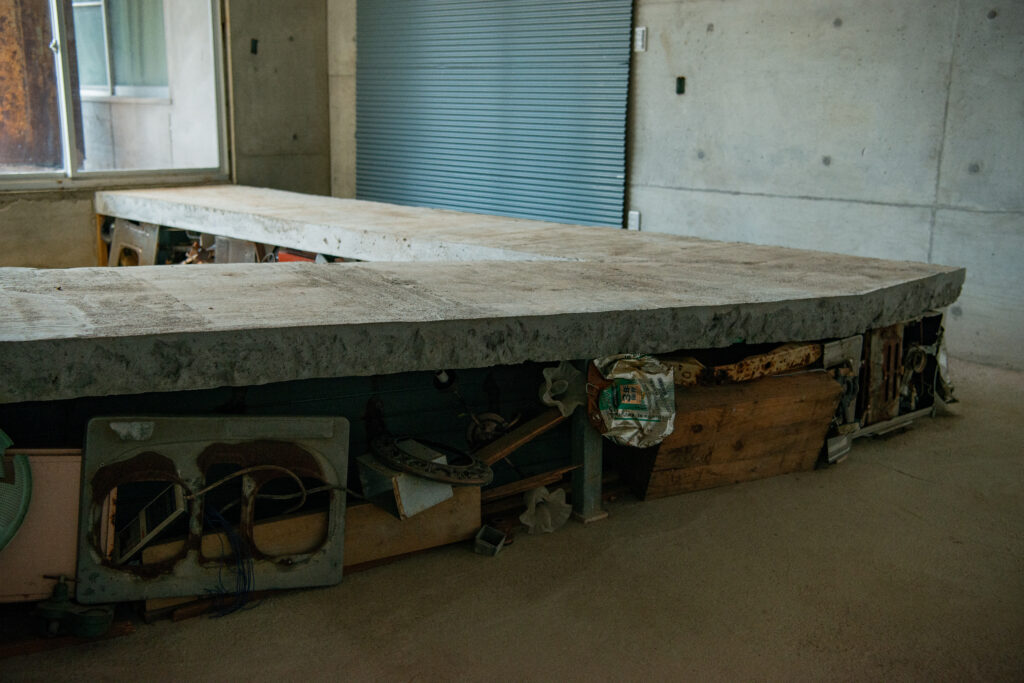
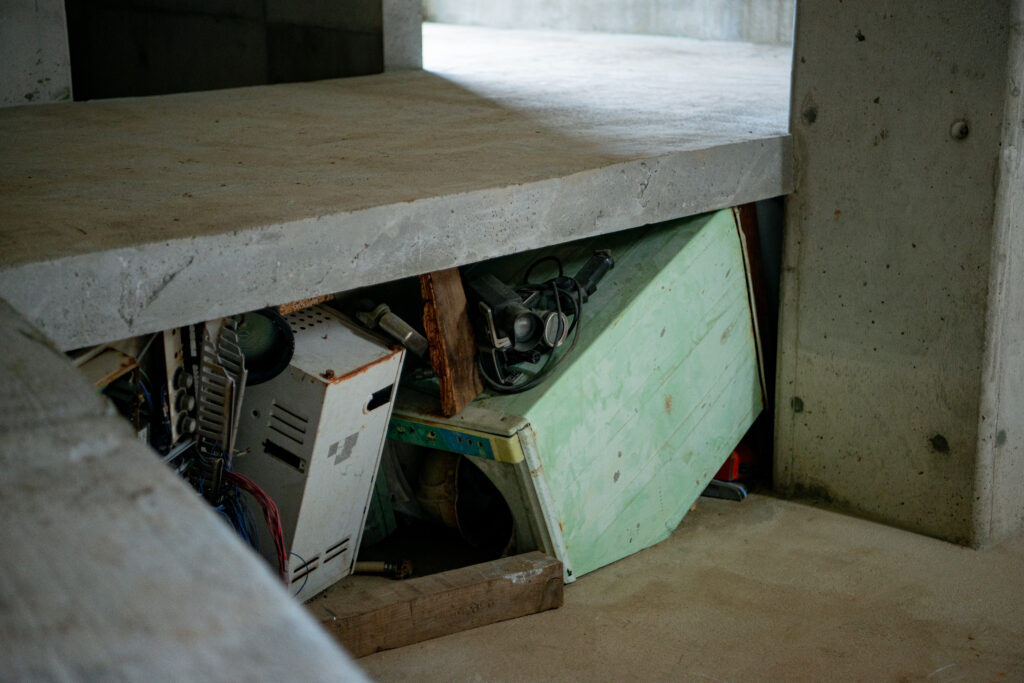
Photo by 長野聰史
「一周の螺旋は円にも見える」motomoto
インスタレーション
Questions and Hopes in a Spiral
Kusumoto Tomoo, Curator at Tsunagi Art Museum
Through the warm rays of sun in late March, I walked past the large quantities of soil piled high, laying my eyes on the fresh green surface in which a long trench-like ditch — as tall a person — was dug out along the building. When descending the staircase carved out of the soil, I was surprised by a nostalgic scent composed of mud and summer grass that flooded my sense of smell even before my sense of vision.
Looking at the earth spread out before me at eye level, I got the feeling that I was transformed into a bug and that I had acquired “bug-vision” much like one would imagine from Kuribayashi Sato’s photographs. The soil in the ditch was layered and mixed with waste such as gray concrete pieces and black plastic bags, exposing the past activities of humans that should have been obscured by the landscape on the surface. At the end of the ditch, which is also a mark of the enormous labor of hand digging, there is a slope leading to ground level, which leads to the inside of the building through a sliding glass door. When I looked under the mortar path, which had been raised from the floor inside the building, I found items that I had seen somewhere, such as electrical appliances that were no longer needed. Further down the path, when I opened the polished glass door at the very end, I was back at the beginning, overlooking the large ditch and the descending dirt stairs, as if I had come around in a circle, but I could not proceed because of the difference in height. For the first time here, I was conscious of the title of this exhibition, “One turn of a spiral looks like a circle.”
A spiral is a three-dimensional line that extends vertically while drawing an arc, but when viewed from above, depending on the angle, the lines overlap and appear as a circle.The same road which transforms from mud to mortar reveals our past and diverse daily life and within it the existence of our appearing and disappearing ambiguous boundaries. The ground covered in fresh green, the ground with layers of soil, the mortar road and the piled up debris below it, the outside and inside – all of these things impress the existence of boundaries in a synchronic and diachronic way and inquire into their significance. It seems to show that, even if humanity keeps progressing, the boundaries creating separation of areas will not cease to exist, but instead these different worlds will forever continue to coexist. Or perhaps it is showing that the concept of progress is actually an error and that we are just repeating the same thing endlessly.
By the way, Kazuhiko KOMATSU, a folklorist who is also considered to be a leading expert in yokai research, said that yokai, created by anxiety about the darkness of the human mind and events that cannot be explained by theory, appear on the boundaries between worlds. Komatsu refers to the outer realm beyond the understanding of everyday life. If we suppose that the world we saw standing at the end of the mortar road was one that surpassed our sensitive thresholds, then the doorway is a boundary to a spiritual world, and the affixed frosted glass is a mirror reflecting the heart of the person standing before it. In other words, it might also be looking at the forced situation in which we are in, and that we no longer have to rely on abilities beyond human human knowledge to continue to climb the spiral that might be unfurling beyond the doorway.
On the other hand, humanity has managed to live with wisdom while facing many crises. In archeology and folklore, one of the forms of spirals is said to have the meaning of amulet. Perhaps it is a bit too deep to try to find a little hope for the future of humanity by feeling the intention of the folklorist Nobuo Orikuchi, who tried to unravel the world view peculiar to the Japanese through the thought of the ancients in this exhibition. In this exhibition, I was able to feel Inoue’s intentions, like those of Nobuo Orikuchi, who attempted to unravel the unique Japanese world view through the ideas of the ancients, and also a small but certain sense of hope for humanity, or would that be examining too deeply?
Spiral or Circular Motion in Body and Language
Shinichi Hanada (Curator / Associate Professor, Faculty of Art and Regional Design, Saga University)
It’s been a long time since I’ve seen such a powerful installation. It’s a real pleasure. Presently, there are many expressions using digital tools such as video and the Internet, as well as relational expressions that weave events while engaging local people, and it is rare to have an absolute physical expression that is vividly represented by such a large amount of work and material.
For this exhibition, Inoue dug a hole in the ground along the side of the motomoto building to the exhibition entrance in the rear, creating a trench-like approach. Dirt and mud are exposed in the trenches, and through my own weak sense of smell, I could still feel the thick richness of the soil and grass hanging in the air. On the path, walking past the bumpy soil, careful not to lose my steps up and down the slope, the sensation of supreme excitement, like that of childhood and playing with the soil, was juxtaposed with the feeling of dizziness of the mind-boggling labor that was endlessly repeated.
Going towards the back of the building and entering the exhibition room through the opening of the glass window, the inside is a hard-boiled space surrounded by concrete. The mortar walkway invites visitors from the entrance to the exit of the exhibition room. In the crevices of the raised sidewalk towering over the floor, old daily necessities and electrical appliances are randomly stacked and hidden from view. When you proceed to the far end of the walkway, you come to an exit through a door. When you open it, the outdoor scenery readily presents itself, but the door position is higher than the ground, so once you realize it, you look down on the trench that you just passed below your feet. That drop is about one meter high. If you were to go out the door without thinking, you would definitely get hurt.
Let’s look at the movement of the visitors while remembering the exhibition title, “One turn of a spiral looks like a circle.” Visitors move from the site entrance through the trench on the side of the building towards the exhibition room, then follow the indoor walkway to the exit. Throughout the entire journey, the visitors will make a spiral circular motion along a gradual height difference.
Inoue has dealt with the contrast between nature and culture in his works such as “Connecting the Sea” (2019) and “Showing the Scenery of the City to A Caught Fish” (2021). He has also dealt with the shift of viewpoints in his works such as “Extended the Stairs of Mt.Hiyoriyama to a New Point of View” (2021) and “Raising the Floor” (2022). In this exhibition, both of these are present. The changes in standing position are generated by a physical experience while contrasting nature and culture, and conceptually, through this, it induces reflection to a viewpoint that overlooks the whole structure.
When we look at human history, we want to take the progressive view of history that our society is gradually rising towards better things while drawing a spiral through the accumulation of wisdom such as civilization, science and technology. However, Inoue says that the spiral motion may be a descent rather than a rise, or it may simply be repeating a circular motion on the same plane.
How could our trivial activities, akin to a hummingbird’s sip, amount to a spiral motion? Or should we keep it to a circular motion? May we shift the contrast between nature and culture to the contrast between action and inaction, or the contrast between infinite and finite? I cannot help but recall the Buddhist idea of reincarnation and Nietzsche’s eternal recurrence. In the first place, we tend to forget that there are blind spots here and there and many things are overlooked, even if we take a bird’s-eye view. Maybe 100 years of life is not enough time, or perhaps, it is too long a span of time. And just like that, my thoughts continue to return to the beginning, going round and round.
螺旋にみる問いと希
楠本智郎(つなぎ美術館学芸員)
3月下旬の暖かい日差しの中、大量に盛られた残土の横を通り、新緑に覆われた地表に目をやると深さが人の背丈ほどもある塹壕のような長い溝が建物に沿って掘られていた。土を削ってつくられた階段で溝の中へ下りると、どこか懐かしい泥土と夏草の入り交じった臭いにむせそうになり、視覚よりも嗅覚による知覚が先行したことに自分でも少々驚いた。
目の高さに地表が広がる、まるで自分が小さな虫になったような感覚は、‘虫の目’を手に入れた栗林慧の昆虫写真とも重なった。溝の土層には灰色のコンクリート片や黒いビニール袋などの廃棄物も混じっており、地表の風景に覆い隠されたはずの人間の過去の営みが剥き出しになっていた。全て手掘りという膨大な労働の痕跡でもある溝の先には地上へと向かうスロープがあり、そこはガラスの引き戸を経て建物内部へとつながっている。建物内部に床からかさ上げされて設けられたモルタルの道の下を覗くと不要になった電化製品など、どこかで目にしたことがある品々が積み上げられていた。さらに道を進み行き止まりにある磨りガラスがはめられた扉を開けると最初に溝へ下りた土の階段を見下ろす位置に大きな円を描くように戻っていたが、高低差があるためにこれ以上は先に進めない。ここで初めて「一周の螺旋は円にも見える」という本展のタイトルを意識した。
螺旋は弧を描きながら垂直方向に延びる三次元の線を意味するが、確かに真上から眺めると線が重なり円に見える場合もある。泥土からモルタルへと変わる1本の道が顕わにするのは、我々の過去の雑多な日常とその中で見え隠れする曖昧なままの境界の存在である。新緑に覆われた地表と土層に挟まれた地下、モルタルの路面とその下に積み上げられた廃棄物、野外と屋内、これらは共時的にも通時的にも境界の存在を印象づけ、その意味を問う。人類が進歩しても領域を隔てる境界がなくなることはなく、永遠にそれぞれの世界が併存し続けることを示しているようにもみえる。いや、進歩したと思っているのは事実誤認であり、実は同じことをいつまでも繰り返しているだけなのかもしれない。
ところで、妖怪研究の第一人者ともされる民俗学者の小松和彦は人間の心の闇や理屈では説明できない事象に対する不安が生み出す妖怪は、異界との境界に現れるとした。小松が言う異界とは日常における理解を超えた外の領域を指している。先ほどのモルタルでできた道の行き止まりの向こうに我々の感性の限界を超える世界が広がるとするならば、まさに扉は異界との境界であり、扉にはまった磨りガラスはそこに立つ者の心を映す鏡であるとも言える。つまり、扉の向こうに続くかもしれない螺旋を登り続けるためには、もはや人知を超えた能力に頼らざるを得ないという我々の追い込まれた状況を示しているとも考えられる。
一方、人類は幾多の危機を迎えながらも知恵を出しながらなんとか生きながらえてきた。考古学や民俗学では螺旋の形態のひとつを平面化した渦巻紋は魔除けの意味を持つとされる。本展に古代人の思想を通じて日本人特有の世界観を解き明かそうとした民俗学者の折口信夫の思想に通じる作意を感じ、人類の未来にささやかな希望を見いだそうとするのはいささか深読みのし過ぎであろうか。
身体と言語による螺旋運動あるいは円運動
花田伸一(キュレーター/佐賀大学芸術地域デザイン学部准教授)
これほど力業なインスタレーションを見たのは久しぶりである。痛快だ。映像やインターネットなどデジタルツールを用いた表現、地域の人々と関わりながら出来事を紡いでいくリレーショナルな表現が数多く見られる現在にあって、これだけの作業量と物量で生々しく勝負する体当たりな表現は珍しい。
今回、井上は motomoto の敷地正面から建物裏の展示入口に至るまでの導線に沿って地面に穴を掘り、塹壕のようなアプローチを作った。掘られた穴は土泥が生々しくむき出しになっており、私自身はほとんど鼻が利かないものの、それでも土や草の濃厚そうなムンムンとした匂いの気配は十分に感じられた。土のでこぼこ、坂の上り下りに足を取られ転ばぬよう、たどたどしく歩を進める途上、土遊びに興じていた幼少期の無上の昂揚を思い起こしたり、延々と繰り返され終わりが見えない肉体労働の徒労感に気が遠くなるような眩暈を覚えたりしながら奥の敷地へ。
建物裏側へと回り込み、ガラス窓の開口部から展示室に入ってみると、中はコンクリートに囲まれたハードボイルドな空間。土方(ドカタ)感あふれるモルタル塗りの歩道が鑑賞者を展示室入口から出口へと誘う。床面から嵩(カサ)上げされた歩道の嵩部分には古びた日用品や電化製品などがランダムに積み重ねられモルタルの隙間から見え隠れしている。歩道を奥まで進むと突き当り出口にドア。開けてみると室外の景色が目に飛び込むが、ドア位置が地面より高いため、眼下に先ほど通ってきた塹壕を見下ろす格好となる。その落差1メートルほどか。何も考えずにドアから外へ出ると確実に怪我をする。
「一周の螺旋は円にも見える」との展覧会タイトルを思い起こしつつ鑑賞者の動きを見てみよう。鑑賞者は敷地入口から建物脇の塹壕を通って展示室内へ、さらに室内の歩道に沿って出口まで移動する。その道のり全体を通して鑑賞者は緩やかな高低差を伴う螺旋状の円運動をすることになる。
井上はこれまで《海を繋ぐ》(2019)、《釣れた魚に街の風景を見せる》(2021)などの作品で自然と人間の営みの対比を扱ってきた。あるいは《日和山の階段を新しい視点まで延長してみる》(2021)、《床をあげる》(2022)などで視点の移動を扱ってきた。今回の作品ではその両方が含まれる。本作では、感覚的には自然と人間の営みを対比させながら体感的に立ち位置の変化を生ぜしめ、そのことを通じて概念的にはそれら全体を俯瞰する視点への省察を促している。
人類の歴史を俯瞰してみるとき、文明や科学技術など英知の積み重ねによって私たちの社会は螺旋を描きつつ少しずつより良きものに向かって上昇しているはずだとする進歩史観を取りたくなる。が、しかし、見方を変えればその螺旋運動は上昇ではなく下降なのかもしれないし、同一平面上でぐるぐる円周運動を繰り返しているだけなのかもしれない、と井上は語る。
ハチドリの一滴のような私たちのちっぽけな活動はいかに螺旋たりえるか、いや、円にとどめておくべきなのか。自然と人間の営みの対比(nature/culture)を無為/有為の対比へとずらして考えても良いかもしれない、あるいは無限/有限の対比か。仏教の輪廻思想やニーチェの永劫回帰を思い起こさずにはいられない。また、そもそも俯瞰しているつもりでも、そこかしこに死角があって多くの事が見逃されていることも私たちは忘れがちだ。たかだか人生100年程度では時間が足りない、いや、長すぎるのかもしれない。そして思考はどこまでも堂々巡りのまま振り出しに戻りつづける。

